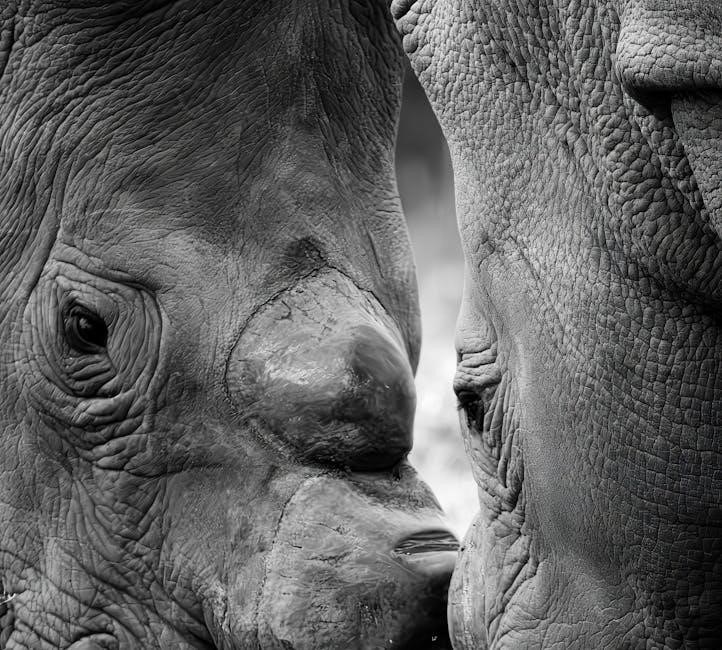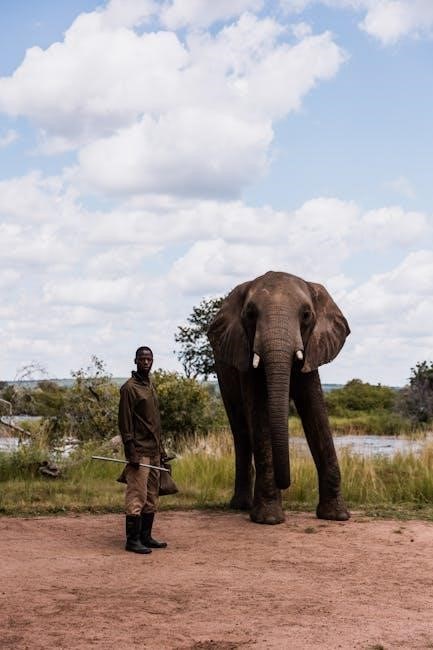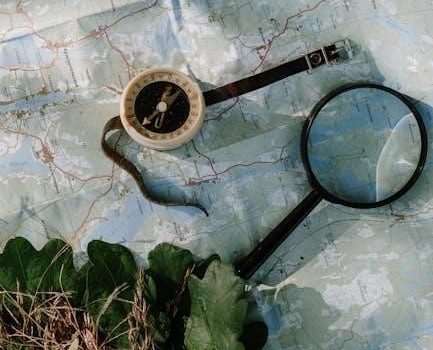black rhino guide
Category : Guide
The black rhino, a critically endangered species, faces severe threats from poaching and habitat loss. Conservation efforts, notably in Kenya, have helped increase their population, offering hope for survival.
Overview of the Black Rhino Species
The black rhino, a critically endangered species, is one of the most threatened large animals in Africa. Native to grasslands and woodlands, they are primarily herbivores, relying on plants for sustenance. Despite conservation efforts, their population remains fragile due to relentless poaching for their horns.
Conservation initiatives, particularly in Kenya, have shown promise, with populations more than doubling since the 1980s. However, habitat loss and human-wildlife conflict persist as significant challenges. The black rhino’s aggressive nature adds to the complexity of their conservation, emphasizing the need for continued protection and sustainable practices to ensure their survival.
Importance of Conservation Efforts
Conservation efforts are critical to prevent the extinction of black rhinos, threatened by poaching and habitat loss. These initiatives protect not only rhinos but also their ecosystems, benefiting other species. Success stories, like Kenya’s population growth, highlight the impact of organized conservation. Continued protection is essential to ensure the survival of this iconic species and maintain biodiversity.

Physical Characteristics of Black Rhinos
Black rhinos are large animals with prominent horns and gray skin. They are smaller than white rhinos but have longer horns, averaging around 60 centimeters.
Distinguishing Features
Black rhinos are identified by their distinctive horns, tough gray skin, and triangular upper lips. Their horns, made of keratin, can grow up to 60 centimeters. Adults typically weigh between 800-1,400 kilograms, with males being slightly larger than females. Newborn calves weigh around 35-40 kilograms, showcasing their impressive growth rate in early life.
Size and Weight Comparisons
Black rhinos are among the largest land animals, with adults weighing 800-1,400 kilograms. They stand approximately 1.4-1.7 meters tall at the shoulder. Comparatively, males are slightly larger than females. Newborn calves weigh around 35-40 kilograms, growing rapidly in their first years. Their size and weight make them formidable creatures, with a stocky build adapted for strength and endurance.

Habitat and Distribution
Black rhinos primarily inhabit eastern and southern Africa, dwelling in diverse habitats, including savannas, grasslands, and woodlands. Their range spans countries like Kenya, South Africa, and Namibia, adapting to varied terrains.
Geographical Range
Black rhinos are primarily found in eastern and southern Africa, with significant populations in Kenya, South Africa, Namibia, and Zimbabwe. Historically widespread, their range has diminished due to habitat loss and poaching, now confined to protected areas and conservation sites, emphasizing the need for targeted preservation efforts to safeguard their remaining territories.
Preferred Habitats
Black rhinos inhabit grasslands, savannas, and woodlands, favoring areas with abundant vegetation and water sources. They thrive in diverse habitats, from dense thickets to open plains, relying on these environments for food and shelter. Their adaptability allows them to survive in various ecological conditions, though access to water remains critical for their survival and overall well-being in the wild.

Behavior and Lifestyle
Black rhinos are primarily solitary animals, with females tending to their calves and males often wandering larger territories. They exhibit territorial behavior and have a highly developed sense of smell, which aids in foraging and detecting threats in their environment. Despite their size, they can move swiftly when necessary, ensuring their survival in the wild.
Feeding Habits
Black rhinos are herbivores, primarily feeding on grasses, leaves, and fruits. They use their distinctive lips to grasp vegetation, allowing them to efficiently browse. Their diet varies seasonally, adapting to available resources, and they often visit waterholes daily to drink, playing a crucial role in shaping their ecosystems through their feeding activities.
Aggressive Nature
Black rhinos are known for their territorial and unpredictable nature, often displaying aggression when threatened. They charge with force, making them dangerous during encounters. This behavior, while defensive, contributes to their intimidating reputation, especially during safaris, where such interactions can be particularly unsettling for observers.

Conservation Status
Black rhinos are critically endangered, with populations slowly recovering due to conservation efforts. Their numbers have increased, but ongoing threats like poaching and habitat loss persist.
Current Population Numbers
Black rhino populations have shown a gradual increase due to conservation efforts. Kenya’s population has more than doubled, rising from fewer than 400 in the 1980s to over 1,000 today. This growth highlights the effectiveness of targeted initiatives, though global numbers remain fragile due to persistent threats like poaching and habitat encroachment.
Endangered Status
Black rhinos are classified as critically endangered by the IUCN, with their population severely threatened by poaching for horns and habitat loss. Despite conservation efforts, the species remains highly vulnerable, with over 10,000 rhinos killed in the last decade. Their survival hinges on continued protection and anti-poaching initiatives to stabilize and grow their fragile population.
Threats to Black Rhinos
Black rhinos face critical threats from poaching for their horns, habitat loss due to human expansion, and escalating human-wildlife conflict, endangering their survival significantly.
Poaching for Horns
Poaching for their horns remains the primary threat to black rhinos, driven by high demand on the black market. Over 10,000 rhinos have been killed in the last decade, fueling illegal trade networks. This relentless hunting has severely impacted populations, undermining conservation gains and threatening the species’ survival, despite global efforts to combat wildlife crime and protect these majestic creatures.
Habitat Loss
Habitat loss, driven by human population growth and land conversion for agriculture and urbanization, threatens black rhino survival. Ecosystem fragmentation reduces available grazing areas and isolates populations, making it harder for rhinos to find food and mates. This loss exacerbates vulnerability to poaching and climate change, underscoring the urgent need for habitat preservation to ensure the species’ survival and ecological balance.
Human-Wildlife Conflict
Human-wildlife conflict arises as black rhinos encroach on farmland and water sources due to habitat loss. This leads to injuries or fatalities for both humans and rhinos, intensifying local tensions. Such conflicts often result in retaliatory killings, further threatening the species. Addressing these issues requires balancing human needs with conservation efforts to prevent escalation and protect rhino populations effectively.

Conservation Efforts
Global initiatives, supported by WWF and the IUCN, focus on protecting black rhinos through anti-poaching measures, habitat restoration, and community engagement. Kenya’s Black Rhino Action Plan and the $150 million Sustainable Development Bond highlight the collaborative efforts to safeguard this species and its ecosystems for future generations.
Anti-Poaching Measures
Efforts include deploying rangers, using surveillance technology, and engaging local communities. The IUCN SSC African Rhino Specialist Group supports anti-poaching initiatives, while organizations like WWF fund ranger training and equipment. These measures aim to disrupt illegal activities and protect vulnerable rhino populations in their natural habitats, ensuring their safety and fostering a secure environment for their survival.
Habitat Preservation
Habitat preservation is crucial for black rhino survival, focusing on protecting natural environments and creating safe havens. Efforts include establishing sanctuaries and monitoring programs to ensure their habitats remain intact. Collaborative initiatives between governments and conservation groups, like WWF, aim to restore ecosystems and prevent further habitat loss, ensuring black rhinos have secure spaces to thrive and reproduce, safeguarding their future.
Kenya’s Black Rhino Population
Kenya’s black rhino population has significantly increased, from fewer than 400 in the 1980s to over 1,000 today, thanks to dedicated conservation efforts and protection plans.
Population Growth
Kenya’s black rhino population has seen remarkable growth, rising from fewer than 400 individuals in the 1980s to over 1,000 today. This success is attributed to stringent conservation measures, habitat preservation, and anti-poaching initiatives. Efforts by organizations like WWF and the Kenyan government have been instrumental in safeguarding this critically endangered species, ensuring a promising future for black rhinos in the region.
Role of Kenya in Conservation
Kenya plays a pivotal role in black rhino conservation through its Black Rhino Action Plan, supported by WWF. The plan establishes strategies for habitat protection, anti-poaching, and community engagement. Kenya’s efforts have significantly contributed to population recovery, making it a model for conservation initiatives across Africa and underscoring its commitment to protecting this endangered species effectively.
Human Impact on Black Rhino
Human activities, such as poaching and habitat destruction, severely threaten black rhinos. The growing human population accelerates ecosystem loss, making conservation efforts critical to their survival and recovery.
Effects of Human Population Growth
Rapid human population growth has led to widespread habitat loss and fragmentation, reducing the natural spaces where black rhinos can thrive. Urban expansion and agriculture encroach on wild areas, forcing rhinos into smaller, isolated regions.
This growth also increases demand for resources, escalating poaching and human-wildlife conflict. As ecosystems shrink, conservation efforts must adapt to protect rhinos and their habitats from these pressing threats.
Ecosystem Loss
Ecosystem loss due to deforestation and land conversion severely impacts black rhino habitats, reducing their natural grazing and shelter areas. This habitat fragmentation isolates rhino populations, making survival and reproduction challenging.
Loss of biodiversity and ecological balance further threatens the species, as rhinos rely on specific vegetation for food. Conservation efforts must address habitat restoration to ensure the long-term survival of these critically endangered animals.

Monitoring and Tracking
Monitoring and tracking black rhinos involve advanced techniques to ensure their safety and study their behavior. Technicians play a crucial role in tracking rhinos to monitor population growth and anti-poaching efforts.
Techniques Used
Techniques used in monitoring black rhinos include camera traps for remote observation, radio collars for real-time tracking, and foot patrols by trained experts. These methods help in gathering data on population dynamics and ensuring their safety. Technicians like Ester van der Merwe play a vital role in these efforts, supported by technology and funding from initiatives like the sustainable development bond.
Role of Technicians
Technicians play a crucial role in black rhino conservation by monitoring populations and implementing anti-poaching measures. They use tools like radio collars and camera traps to track rhinos effectively. Their work ensures data accuracy and supports conservation strategies. Technicians collaborate with experts to protect habitats and educate communities, contributing to the survival of this endangered species.

Economic Factors
The black market trade of rhino horns fuels illegal economies, while conservation funding remains critical to protect these animals and their habitats from extinction threats.
Impact of Black Market Trade
The black market trade of rhino horns has led to significant population declines, with nearly 10,000 rhinos poached in the last decade. This illegal trade drives demand, undermining conservation efforts and threatening the species’ survival. The economic incentives for poachers perpetuate the cycle of exploitation, making it a critical issue in rhino conservation strategies.
Funding for Conservation
Funding for black rhino conservation is vital, with organizations like WWF supporting initiatives such as Kenya’s Black Rhino Action Plan. A $150 million Sustainable Development Bond has also been allocated to conservation efforts. These funds are crucial for anti-poaching measures, habitat preservation, and research, ensuring the survival of this endangered species through collaborative efforts and sustained financial support.

Cultural Significance
Cultural Perceptions
Black rhinos hold significant cultural value, symbolizing strength and resilience in many societies. Traditional beliefs often associate them with good luck and spiritual powers, though this has inadvertently fueled demand for their horns.
Black rhinos are deeply embedded in cultural and traditional beliefs across Africa and Asia. Many view them as symbols of strength, resilience, and spiritual power. However, these perceptions often fuel demand for their horns, mistakenly believed to possess medicinal properties, further endangering the species and complicating conservation efforts.
Traditional Beliefs
Traditional beliefs in many cultures attribute mystical and medicinal properties to black rhino horns, driving illegal demand. Despite scientific evidence disproving these claims, horns remain highly valued, fueling poaching. Such beliefs are deeply rooted in cultural practices, making them a significant challenge for conservationists aiming to protect this endangered species.
Tourism’s Role
Ecotourism plays a vital role in black rhino conservation by generating revenue and raising awareness. Safaris create jobs and fund protection efforts, aiding their survival despite challenges.
Ecotourism Benefits
Ecotourism significantly supports black rhino conservation by generating revenue for protection efforts. Safari tourism creates jobs, fostering community engagement and funding anti-poaching initiatives. By promoting wildlife awareness, it encourages global support for conservation, aiding in the recovery of this endangered species while balancing human and wildlife coexistence.
Challenges in Safari
Safaris face challenges such as habitat loss and human-wildlife conflict, affecting black rhino sightings. Climate change alters ecosystems, while poaching remains a constant threat. Ensuring safe and ethical tours requires skilled guides and strict regulations to protect both animals and visitors, balancing conservation with tourism demands.

Technology in Conservation
Technology plays a vital role in black rhino conservation through GPS tracking, camera traps, and monitoring systems, aiding in anti-poaching efforts and habitat preservation.
Use of Technology
Technology is crucial in black rhino conservation, with GPS tracking devices, camera traps, and monitoring systems aiding in real-time surveillance. Drones and sensors detect poaching activities, while data analytics predict threats. Funding from initiatives like the Sustainable Development Bond supports these innovations, enabling technicians to monitor rhino movements effectively and protect habitats. Such tools enhance anti-poaching strategies and ensure species survival;
Future Innovations
Future innovations in black rhino conservation may include advanced AI-driven monitoring systems and biometric identification to track rhinos more effectively. Drones with enhanced capabilities could provide real-time surveillance, while predictive analytics might anticipate poaching hotspots. Such technologies, supported by global funding initiatives, aim to safeguard rhino populations and habitats, ensuring long-term survival and countering emerging threats to these majestic creatures.
Legal Frameworks
Legal frameworks play a crucial role in protecting black rhinos by enforcing anti-poaching laws and regulating wildlife trade, ensuring stricter penalties for illegal activities threatening their survival.
International Laws
International laws, such as CITES, regulate the trade of black rhino horns, imposing strict penalties for illegal activities. These laws aim to protect the species by enforcing bans on horn sales and promoting global cooperation in conservation efforts. The IUCN Red List categorizes black rhinos as critically endangered, further necessitating international legal protections to ensure their survival.
National Policies
National policies, such as Kenya’s Black Rhino Action Plan, aim to protect rhino populations through anti-poaching laws and habitat preservation. These policies often involve collaboration with conservation organizations to enforce strict penalties for illegal activities and promote sustainable land use, ensuring the survival of black rhinos within protected areas and national parks.
Black rhinos face critical threats, but conservation efforts, like Kenya’s population growth and anti-poaching measures, offer hope. Continued global support is essential for their survival and ecosystem preservation.
Black rhinos are critically endangered due to poaching and habitat loss. Conservation efforts, including anti-poaching measures and habitat preservation, have shown success, particularly in Kenya, where populations have doubled. Continued global support and sustainable funding are essential to protect this species and its ecosystems, ensuring their survival for future generations.
Call to Action
Take action now to protect black rhinos by supporting conservation efforts and spreading awareness. Donate to reputable organizations, advocate for anti-poaching laws, and participate in eco-friendly initiatives. Together, we can ensure the survival of this majestic species and preserve their place in our world for future generations to cherish and protect.
